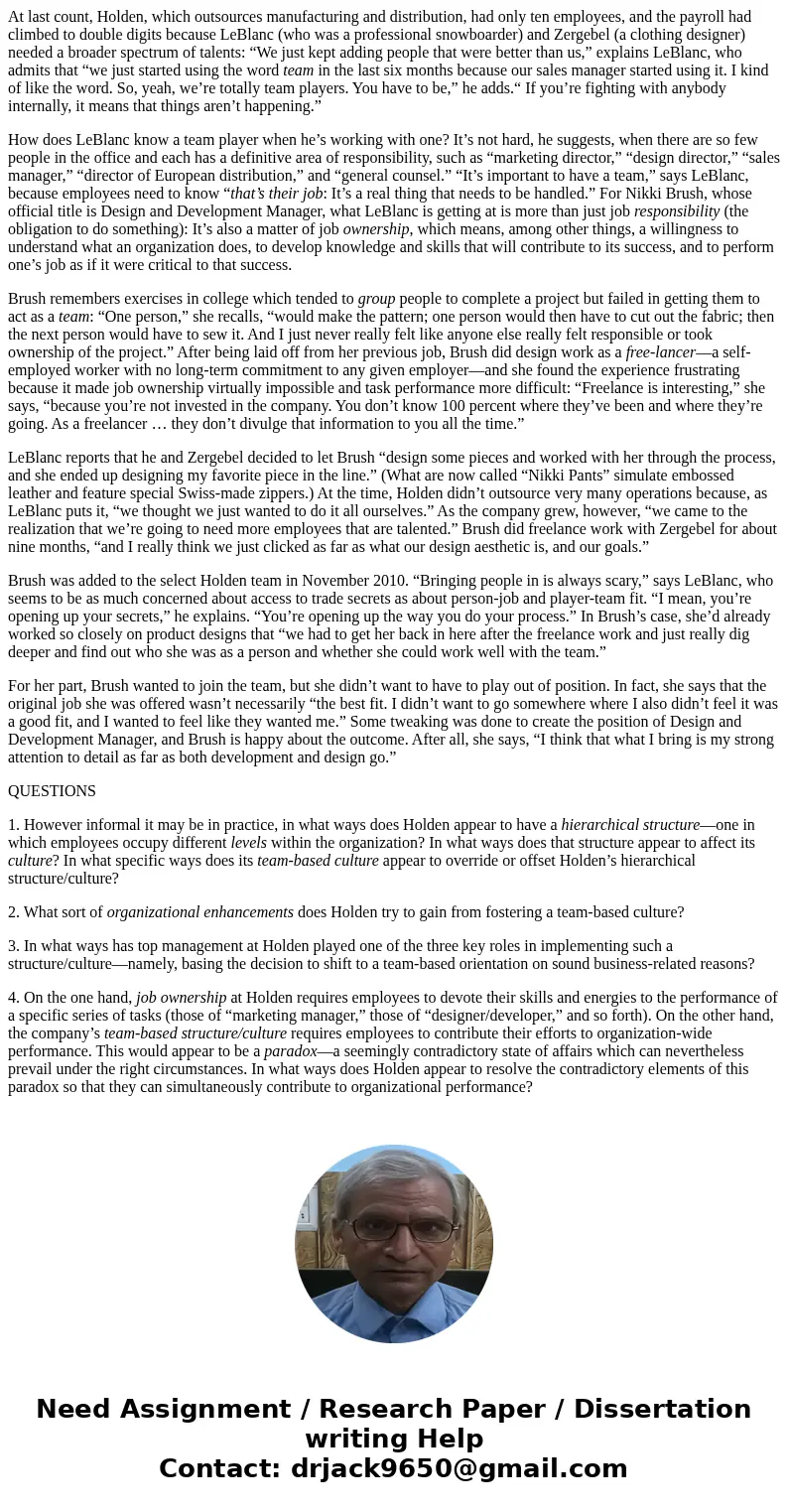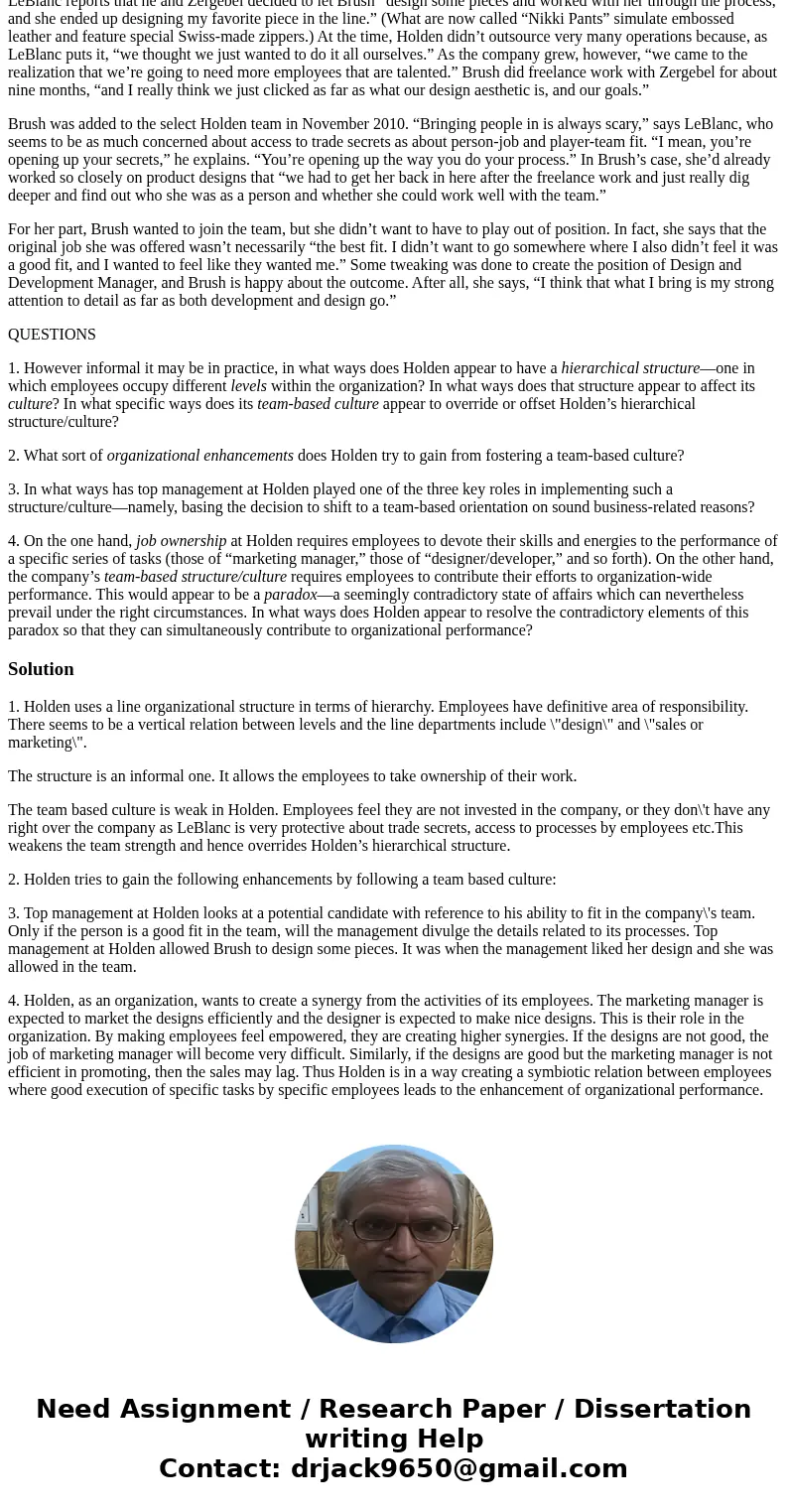At last count Holden which outsources manufacturing and dist
At last count, Holden, which outsources manufacturing and distribution, had only ten employees, and the payroll had climbed to double digits because LeBlanc (who was a professional snowboarder) and Zergebel (a clothing designer) needed a broader spectrum of talents: “We just kept adding people that were better than us,” explains LeBlanc, who admits that “we just started using the word team in the last six months because our sales manager started using it. I kind of like the word. So, yeah, we’re totally team players. You have to be,” he adds.“ If you’re fighting with anybody internally, it means that things aren’t happening.”
How does LeBlanc know a team player when he’s working with one? It’s not hard, he suggests, when there are so few people in the office and each has a definitive area of responsibility, such as “marketing director,” “design director,” “sales manager,” “director of European distribution,” and “general counsel.” “It’s important to have a team,” says LeBlanc, because employees need to know “that’s their job: It’s a real thing that needs to be handled.” For Nikki Brush, whose official title is Design and Development Manager, what LeBlanc is getting at is more than just job responsibility (the obligation to do something): It’s also a matter of job ownership, which means, among other things, a willingness to understand what an organization does, to develop knowledge and skills that will contribute to its success, and to perform one’s job as if it were critical to that success.
Brush remembers exercises in college which tended to group people to complete a project but failed in getting them to act as a team: “One person,” she recalls, “would make the pattern; one person would then have to cut out the fabric; then the next person would have to sew it. And I just never really felt like anyone else really felt responsible or took ownership of the project.” After being laid off from her previous job, Brush did design work as a free-lancer—a self-employed worker with no long-term commitment to any given employer—and she found the experience frustrating because it made job ownership virtually impossible and task performance more difficult: “Freelance is interesting,” she says, “because you’re not invested in the company. You don’t know 100 percent where they’ve been and where they’re going. As a freelancer … they don’t divulge that information to you all the time.”
LeBlanc reports that he and Zergebel decided to let Brush “design some pieces and worked with her through the process, and she ended up designing my favorite piece in the line.” (What are now called “Nikki Pants” simulate embossed leather and feature special Swiss-made zippers.) At the time, Holden didn’t outsource very many operations because, as LeBlanc puts it, “we thought we just wanted to do it all ourselves.” As the company grew, however, “we came to the realization that we’re going to need more employees that are talented.” Brush did freelance work with Zergebel for about nine months, “and I really think we just clicked as far as what our design aesthetic is, and our goals.”
Brush was added to the select Holden team in November 2010. “Bringing people in is always scary,” says LeBlanc, who seems to be as much concerned about access to trade secrets as about person-job and player-team fit. “I mean, you’re opening up your secrets,” he explains. “You’re opening up the way you do your process.” In Brush’s case, she’d already worked so closely on product designs that “we had to get her back in here after the freelance work and just really dig deeper and find out who she was as a person and whether she could work well with the team.”
For her part, Brush wanted to join the team, but she didn’t want to have to play out of position. In fact, she says that the original job she was offered wasn’t necessarily “the best fit. I didn’t want to go somewhere where I also didn’t feel it was a good fit, and I wanted to feel like they wanted me.” Some tweaking was done to create the position of Design and Development Manager, and Brush is happy about the outcome. After all, she says, “I think that what I bring is my strong attention to detail as far as both development and design go.”
QUESTIONS
1. However informal it may be in practice, in what ways does Holden appear to have a hierarchical structure—one in which employees occupy different levels within the organization? In what ways does that structure appear to affect its culture? In what specific ways does its team-based culture appear to override or offset Holden’s hierarchical structure/culture?
2. What sort of organizational enhancements does Holden try to gain from fostering a team-based culture?
3. In what ways has top management at Holden played one of the three key roles in implementing such a structure/culture—namely, basing the decision to shift to a team-based orientation on sound business-related reasons?
4. On the one hand, job ownership at Holden requires employees to devote their skills and energies to the performance of a specific series of tasks (those of “marketing manager,” those of “designer/developer,” and so forth). On the other hand, the company’s team-based structure/culture requires employees to contribute their efforts to organization-wide performance. This would appear to be a paradox—a seemingly contradictory state of affairs which can nevertheless prevail under the right circumstances. In what ways does Holden appear to resolve the contradictory elements of this paradox so that they can simultaneously contribute to organizational performance?
Solution
1. Holden uses a line organizational structure in terms of hierarchy. Employees have definitive area of responsibility. There seems to be a vertical relation between levels and the line departments include \"design\" and \"sales or marketing\".
The structure is an informal one. It allows the employees to take ownership of their work.
The team based culture is weak in Holden. Employees feel they are not invested in the company, or they don\'t have any right over the company as LeBlanc is very protective about trade secrets, access to processes by employees etc.This weakens the team strength and hence overrides Holden’s hierarchical structure.
2. Holden tries to gain the following enhancements by following a team based culture:
3. Top management at Holden looks at a potential candidate with reference to his ability to fit in the company\'s team. Only if the person is a good fit in the team, will the management divulge the details related to its processes. Top management at Holden allowed Brush to design some pieces. It was when the management liked her design and she was allowed in the team.
4. Holden, as an organization, wants to create a synergy from the activities of its employees. The marketing manager is expected to market the designs efficiently and the designer is expected to make nice designs. This is their role in the organization. By making employees feel empowered, they are creating higher synergies. If the designs are not good, the job of marketing manager will become very difficult. Similarly, if the designs are good but the marketing manager is not efficient in promoting, then the sales may lag. Thus Holden is in a way creating a symbiotic relation between employees where good execution of specific tasks by specific employees leads to the enhancement of organizational performance.


 Homework Sourse
Homework Sourse